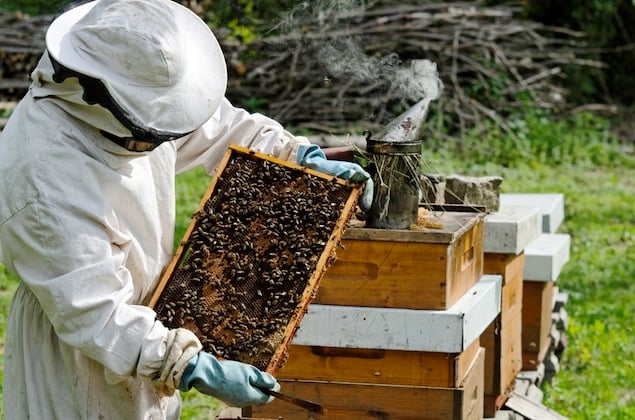 |
| Beekeepers |
Beekeepers are being consulted on two industry levies this month. Beehive numbers have almost trebled in the past 10 years.
Apiculture New Zealand wants to introduce a commodity levy of 10c per kilo of honey sold, to raise about $2million annually.
''We can't have growth without pain, and this levy is really to help control or cope some of the growing pains,'' apiarist Russell Marsh, of Marsh's Honey in Ettrick, said.
Beekeepers will also be asked to make submissions on increasing the existing apiary and beekeeper levy to combat American foulbrood (AFB).
ApiNZ's subsidiary Management Agency National American Foulbrood Pest Management Plan wants to raise a further $2.15million to fight the disease, in addition to the $1million apiarists already pay.
The maximum annual levy rate is proposed to increase from $20 to $40 per beekeeper, and from $15.17 to $50 per apiary, and the increase will be phased in over five years.
Both consultations were announced at the recent industry conference in Blenheim.
ApiNZ chief executive Karin Kos said about 40% of the commodity levy funds raised would go to research, about 20% to biosecurity, 10% towards running the organisation and the balance would be spent on bee health, advocacy, education, industry support, attracting new people, and leveraging funding from sources such as the Sustainable Farming Fund.
National compliance manager Clifton King said the AFB management plan was introduced in 1998 to combat the disease but as they did not have enough funding, they were unable to control it.
''From 1998 to 2013, the plan was supposed to reduce the level of AFB by 10% a year, and from 2013 to now, it was supposed to reduce levels by 5% a year,'' Mr King said.
‘‘In the past 20 years, the average reduction was 0.8% per year, and we have not been making the difference that we should have been.
‘‘Since 2015, the [incidence of] AFB has been increasing by 15% per year.’’
He said the lack of funding meant the agency did not have the resources to follow up complaints, compliance, control, surveillance, inspections and enforcement.
By increasing the agency’s resources, they would save about 41,000 beehives and associated products worth $50 million from destruction over 10 years, as well as replacing its ApiNet database and increasing surveillance.
Mr Marsh said ‘New Zealand Inc’ (i.e. roading, education, hospitals etc) was ‘‘reliant on horticulture and agriculture, so bee health was a vital part of those sectors being able to grow and deliver.’’
He said while the proposed commodity levy would cost the industry $2million-$3million, it was relative to export income and would be less than 1% of the industry’s current revenues.
‘‘While the levies were an additional cost, what is the cost [to the industry] if we don’t do it?’’ he posed.
‘‘I believe these initiatives are not only an investment in the beekeeping industry but an investment in New Zealand’s future.’’
Honey facts and figures
- Honey exports are worth $329million to New Zealand.
- There are about 900,000 hives owned by 8000 beekeepers in New Zealand, which is an increase from 400,000 five years ago.
- The American foulbrood levy consultation runs for three weeks this month.
- Submissions will be considered in September and if the industry votes for an increased levy, an order will be sent to the Ministry for Primary Industries after that.
- If the MPI accepts the new levy order, it will be in place by March 31, 2019.
- Consultation for the commodity levy continues through August and September, and voting will begin on October 1.
- Voting closes on November 1 and if members vote ‘‘yes’’, a levy order will be recommended to the MPI and if approved, will be in place in July 1, 2019.
- The increased levy would be $55 for a hobbyist with four or fewer apiaries, and the break-even point for the beekeeper would be saving one hive every 22.2 years.
- For a large beekeeper with 146 apiaries, the increase in the levy would be an extra $5100, and they would need to save 4.2 hives per year to break even.
- It costs a beekeeper about $1200 plus a year’s production to have a hive burned due to AFB.





ReplyDeleteHello,
If you want to go into beekeeping business, There are so many company website this days like http://www.virtatrade.com that will enable you as a beginner to raise the fund you need to start up your beekeeping business without you seeking for a loan.
This company is where many business dealers from all over the world generate fund that backup their various businesses financially.
I used this company to backup my cocoa beans export business each time my business is running down.
You can visit and register with the company website here http://www.virtatrade.com to raise the fund you need now to go into your beekeeping business.